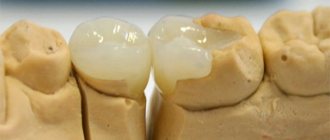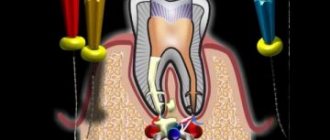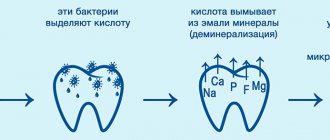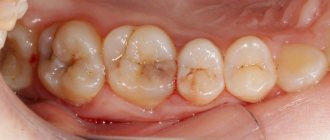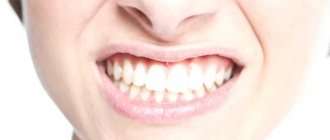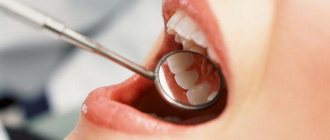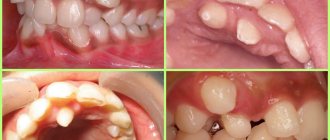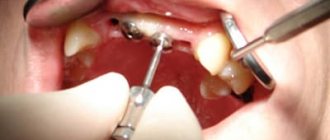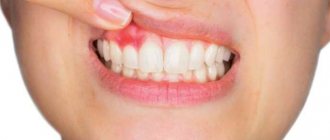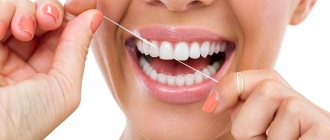Start of treatment
There is a lot of information on the Internet on forums that the first results are detected within a couple of weeks, and sometimes even a few days after installing the system in the oral cavity. There cannot be significant changes within a few hours after installing braces; self-hypnosis works here.
An experienced dentist, before starting treatment, always warns the patient that there are no exact dates regarding the advancement of teeth. There are only indicative data, but they may differ greatly from the real picture.
When installing a braces system, in most cases, the doctor uses a medium-section arch, which has a gentle effect on the teeth. This is necessary in order to gently initiate the beginning of the advancement or revolution of the teeth around their axis. Theoretically, this process can be accelerated by using a thick, rigid arc that will press on the enamel with great force, but this approach will make the adaptation period too uncomfortable and painful. In addition, this can lead to disruption of regeneration and nutritional processes in deep tissues, which do not have time to adapt to rapid changes and significant displacements of tooth roots. To avoid such serious complications, the specialist starts the process slowly. A gradual and slow start is a prerequisite for the success of the further course.
What causes discomfort and pain when installing braces?
Whatever system is installed for the patient, perfect
Incognito
braces or a classic metal structure, the first few days of constant operation of the orthodontic arch will cause discomfort. The neglected process contributes to the development of constant tension in the bone tissue. The ligaments of the upper jaw usually adapt quite quickly: adults stop feeling discomfort after a maximum of 7-10, adolescents - after 3-5 days. In the lower jaw, the bone tissue is denser, so the adaptation process takes a little longer.
Some patients who installed metal, ceramic or sapphire braces in Moscow
, irritation of the mucous membrane of the cheek or lip may occur where they come into contact with the protruding parts of the braces. Owners of internal lingual systems, in turn, may complain of tongue irritation. This nuisance, caused by “rubbing” the mucous membrane, leads to the formation of a protective layer on it, which helps reduce sensitivity in the damaged area and get used to the discomfort. After removing the braces, the tissue will recover quite quickly and without consequences.
The simplicity of the braces system allows the patient to form an even dentition and an attractive smile step by step. Minor inconveniences during treatment can be easily tolerated, especially since the spectacular result is certainly worth the time and effort spent.
The question is often asked: “Why do teeth move slowly?” On the forums you can read messages like the one I quote below:
How fast should teeth move? What can cause the rate of tooth movement to slow down? What mistakes during braces treatment can lead to teeth not moving in the desired direction?
What's happening
After braces are activated, pressure is applied to the crown parts of the teeth located above the gums. But the first changes concern the periodontal ligaments - structures that firmly connect the root and jaw bone. Due to the impact on these ligaments, a person experiences a feeling of pressure, bloating, aching in the jaw, etc. Periodontal attachment is very reliable; it ensures the constancy of the location of each element of the dentition. This area is innervated by nerve endings that respond to pressure, so the first sign that changes have begun to occur is discomfort.
On average, after two to six months, the clinical picture begins to change so much that it becomes noticeable when looking in the mirror or from the side. Cases where the first results are visible within a few weeks are rather the exception to the rule.
If not noticeable
Sometimes it seems to the patient that the system is installed, time passes, but no changes are observed. You should ask your doctor questions like these without hesitation. The fact is that understanding the processes that occur with a person and complete trust in the specialist supervising the treatment are key points that ensure the success of the course. Sometimes the first results are not noticeable during a routine examination. This happens, for example, if at the first stage of bite restoration they struggle with retention. Then the results can only be assessed during an examination in the dentist’s chair or with the help of x-rays, which are performed on the direction of a specialist.
Sometimes it happens that the first results really do not appear for a long time. The specialist will definitely see this and take action. These can range from stronger archwire positioning to a complete overhaul of the treatment plan using different techniques. The latter option occurs very rarely, in approximately 1-1.5% of cases. However this happens, all conclusions are provided and deciphered to the patient, and decisions are made mutually based on the facts and options voiced by the orthodontist.
Prevention of caries under braces: useful tips
- high-quality and regular oral hygiene: today patients have access to all kinds of hygiene products for caring for the braces system, designed to make oral care as easy as possible. The main thing is not to neglect them and use them daily! In the morning and evening - regular and special toothbrushes with a groove for a metal arc, rinsing the mouth, using irrigators,
- Cleaning your teeth after every meal: after eating, be sure to use special dental floss, brush your teeth and use thin floss brushes for hard-to-reach places. Be sure to remove any remaining sweet or sticky foods from your braces.
- proper nutrition: exclude “junk foods” from your diet - chips, nuts, seeds, toffees, chewing gum. They can stick to your braces and damage them. Too hot or too cold foods lead to the same consequence,
- regular visits to the orthodontist: the doctor will not only adjust the force of braces on your teeth, but will also examine and assess the condition of your teeth,
- carrying out professional hygiene: if the doctor recommends or insists on professional teeth cleaning, do not refuse. This procedure is completely painless, it is carried out using modern ultrasound or laser equipment and allows you to remove plaque and tartar from all hard-to-reach places. In addition, the doctor will definitely clean the surface of the teeth with professional means and apply a strengthening fluoride varnish to protect the enamel from external influences and prevent caries.
Damon Q metal braces - only RUR 72,000!
All inclusive! Preparation and treatment of the oral cavity, consultation with an orthodontic specialist, installation and adjustment of orthodontic structures. Color options available for little ones! More details>>> Consultation with a doctor is free! Call now: +7 (495) 789-39-31
Thus, in order for you to never find out what caries under braces is, you need to follow two rules: brush your teeth thoroughly and regularly visit your orthodontist. Remember that each hygiene procedure should take at least 10 minutes - after treatment, your smile will reward you for the time spent.
Price
| Service name | Price |
| Caries of any complexity, except deep | 3,000 rub. |
| Deep caries | 3,000 rub. |
| Seal | 2,000 rub. |
All prices for services
Criteria for evaluation
From the moment braces are installed, any person pays increased attention to their bite. This is explained by the anticipation of the first changes and the forced strengthening of hygiene. It often happens that minor shifts or movements of the teeth simply go unnoticed by the patient, since he observes the oral cavity in great detail every day. And he manages to get used to the results.
Dentists are aware of this feature, so it is common practice to take photographs of the dentition at each scheduled visit to the clinic in order to be able to compare them with each other and compare them with the picture that is currently available. This approach is justified, since photographs can be used to easily assess progress that is invisible to the patient.
Sometimes they compare not only ordinary images, but also x-rays. In modern clinics, a digital model of the bite is performed, showing in accelerated time how the dentofacial apparatus is changing and at what stage of treatment the patient is now. Sometimes classical measurements of the parameters of the dental arches are carried out using a special dental instrument to compare the results with the initial data.
Diagnosis of caries with braces
Hard tooth tissues begin to deteriorate from the moment the enamel demineralizes, and this does not depend on the type of structures installed. If the systems are not removable, then the enamel begins to deteriorate right under them. It becomes simply impossible to clean them. That is why it is so important to periodically consult an orthodontist so that he examines each tooth under the braces and determines whether saliva is leaking into the compound that secures the tooth. If the result of such an examination is positive, you should once again fix the braces to the tooth.
What does the orthodontist do after he has removed the braces? After dismantling the corrective systems, the specialist will have to remove the remaining bonding material and also polish the tooth surface. In addition, he will need to examine the teeth for the presence of caries, not only the surface of the teeth itself, but also the areas between them.
Factors influencing results
How soon it will be obvious that tooth movement has begun to occur depends on several factors:
- Degree of tooth curvature. The more pronounced the pathology is at first, the faster the first changes with braces will be noticeable. Experts note that the alignment of a tooth deviated into the oral cavity or towards the lips occurs faster than the displacement of the entire dentition in the horizontal plane, so in the second case the first results will become noticeable later.
- Age factor. The growth and development of all parts of the body occurs faster in children and adolescents, while in adults there is a natural slowdown in these processes. For this reason, it can be assumed that the younger the patient with braces, the faster the progress will appear, and the entire course will be significantly shortened.
- Individual characteristics . This parameter is associated with the health status and characteristics of the physiological processes of each person. Even people of the same age with the same pathologies and common methods for eliminating them demonstrate different dynamics, so it is very difficult to predict in advance how long it will take to wait for the first changes.
- Bracket type. Metal non-ligature braces are recognized as the most highly effective, so with them movement will be noticeable earlier. Also, the dentition reacts faster to the vestibular systems than to the lingual ones.
- Dentist qualification. The doctor's skills and knowledge allow him to attach the braces exactly as required to quickly begin activation. Deviation from the desired point of attachment of the lock by just a millimeter will greatly slow down the process and, as a result, will not allow you to achieve a perfect bite. An experienced orthodontist can choose exactly the force of pressure on the teeth at which movement will begin in the shortest possible time, but will not lead to damage to the deep structures of the jaw.
Stages
Several months pass before the first noticeable changes occur after the installation of braces, after which the movement in the dentition accelerates significantly. If the total announced period for occlusion correction was 1.5 years, and by the end of the first year changes have not begun, it can be assumed that the treatment will be delayed or significant adjustments will be made to the plan.
Once the changes begin, the pressure increases, so all movements become more noticeable. At the last stage, active processes gradually slow down. The final stage is the retention period, which is necessary to consolidate the effect obtained. Neglecting retention can cause teeth to move back to the positions they were before restoration began.
Dentists against caries
Before installing orthodontic structures, the doctor must treat teeth affected by caries and place fillings. Only after this the orthodontist will proceed to the next stage.
How are braces installed?
- The first step is to thoroughly clean the surface of the teeth from plaque and dirt.
- Next, you need to wait until the tooth is completely dry.
- A special dental glue is applied to the enamel, which will securely hold the system lock.
- The bracket is fixed, and a special lamp is used to harden the glue.
This method of fixation is quite reliable, so the structure remains on the enamel throughout the entire treatment period. In this case, only the metal arcs are periodically changed.
